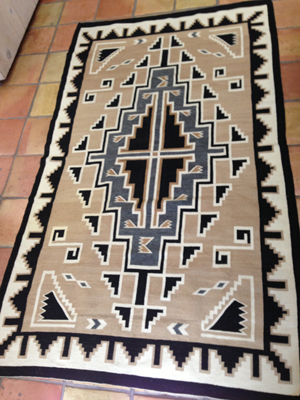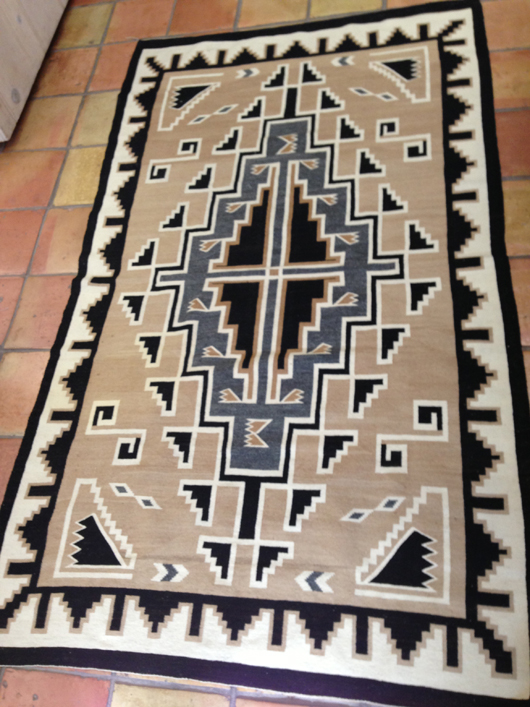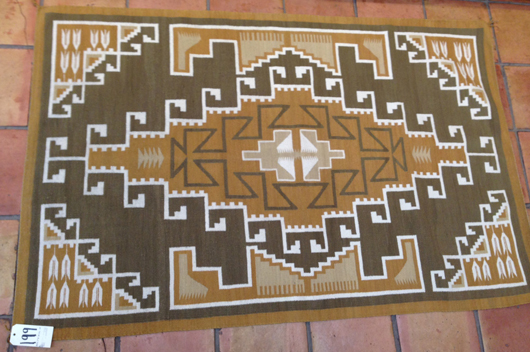
PRESCOTT, Ariz. (AP) – Navajo rugs can start at $25 a pop, while others can shoot up into thousands of dollars at the drop of a hat, or the raising of a hand.
Such is the climate at the Indian Art and Navajo Rug Auction, held annually at Prescott’s historic Smoki Museum. Crowds filled the interior of the historic locale for the 2013 event, which marked its 16th year in Prescott. Auctions took place March 15 and 16, following previews that featured hundreds of examples of contemporary and historic Indian art including pottery, baskets, jewelry, Kachinas and other items. On March 16, 300 Navajo weavings were also put on the auction block for buyers to bid on.
Guards were also on hand to protect the merchandise.
Navajo Trader and auctioneer Bruce Burnham is the fourth generation of a family in the trading business.
“I come by it honestly. We’ve been in the trading business since about 1886,” he said. “My daughter is the next generation and her daughter is the sixth generation in our operation, so it’s a family deal.”
The role of a trader, he explained, is to take care of the community itself.
“That’s what got us involved in rug auctions,” Burnham said. “Growing up, I heard my grandfather tell people that if you want a Navajo rug, now is a good time to buy it, because it’s a dying art. It’s not a dying art. There has never been a time you couldn’t open the back of a store and haul out more rugs than you can sell.”
Burnham, along with his partner Hank Blair, considers trading his way to give back to the Navajo community. Burnham himself lives on the Navajo reservation, but travels frequently to sell rugs throughout the United States. Throughout the course of a year, he’ll travel to Los Angeles and as far as Indianapolis to auction rugs.
“We sell over $1 million in rugs every year at auction. Most of which are rugs directly from the weavers,” Burnham said. “We do about 18 auctions a year.”
Funds from each sale go back to the weavers on the Navajo Reservation, he added. Typically, crafters from the Navajo reservation will line up outside his door to receive their earnings the day after an auction, he said.
The nonprofit Smoki Museum’s mission, according to Executive Director Cindy Gresser, is to instill understanding and respect for the indigenous cultures of the Southwest. Funds raised from the auction help the museum operate.
“It’s our major fundraiser. We seek funding from a variety of sources, but this is a major driver for us economically. We put a lot of effort into it and it’s become one of those auctions that’s very well known in the Southwest,” Gresser said.
The auction itself can often go quickly, she said.
“It depends on what the market is, what people are looking for and what they’re buying these days, but generally speaking we sell a very high percentage of our rugs at auction, 50 percent or better,” Gresser said. “We consign a lot of the merchandise through Ogg’s on Cortez. He’s a fixture here in town, probably the best known Indian art expert in this area.”
Merchandise, she said, can range from relatively inexpensive to very costly.
“Here you can get a small Navajo rug, that maybe isn’t in the best condition, but can be restored to something beautiful, up to something worth, literally, tens of thousands of dollars,” Gresser said.
Smoki Museum Docent Linda Young served as chairwoman for the recent rug auction. She has volunteered at the museum for nine years. While art at the auction hails from a number of tribes, rugs hail strictly from the Navajo reservation, she said.
The weekend auction was held in the historic Pueblo building, the original clubhouse for the Smoki people, built in 1931.
Copyright 2013 Associated Press. All rights reserved. This material may not be published, broadcast, rewritten, or redistributed.
AP-WF-03-22-13 0705GMT
ADDITIONAL IMAGES OF NOTE



